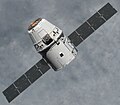 Promotional Poster | |
| Mission type | Long-duration expedition |
|---|---|
| Expedition | |
| Space station | International Space Station |
| Began | 27 April 2012, 08:15 UTC [1] |
| Ended | 1 July 2012, 04:48 UTC [2] |
| Arrived aboard | Soyuz TMA-03M Soyuz TMA-04M |
| Departed aboard | Soyuz TMA-03M Soyuz TMA-04M |
| Crew | |
| Crew size | 6 |
| Members | Expedition 30/31: Oleg Kononenko André Kuipers Don Pettit Expedition 31/32: Joseph M. Acaba Gennady Padalka Sergei Revin |
 Expedition 31 mission patch  (l-r) Acaba, Padalka, Revin, Kuipers, Kononenko and Pettit | |
Expedition 31 was the 31st long-duration expedition to the International Space Station (ISS). It began on 27 April 2012 with the departure from the ISS of the Soyuz TMA-22 spacecraft, which returned the Expedition 30 crew to Earth. [1] The expedition ended on 1 July 2012, when crew members Oleg Kononenko, André Kuipers and Don Pettit departed from the ISS aboard Soyuz TMA-03M, marking the beginning of Expedition 32. [2]






